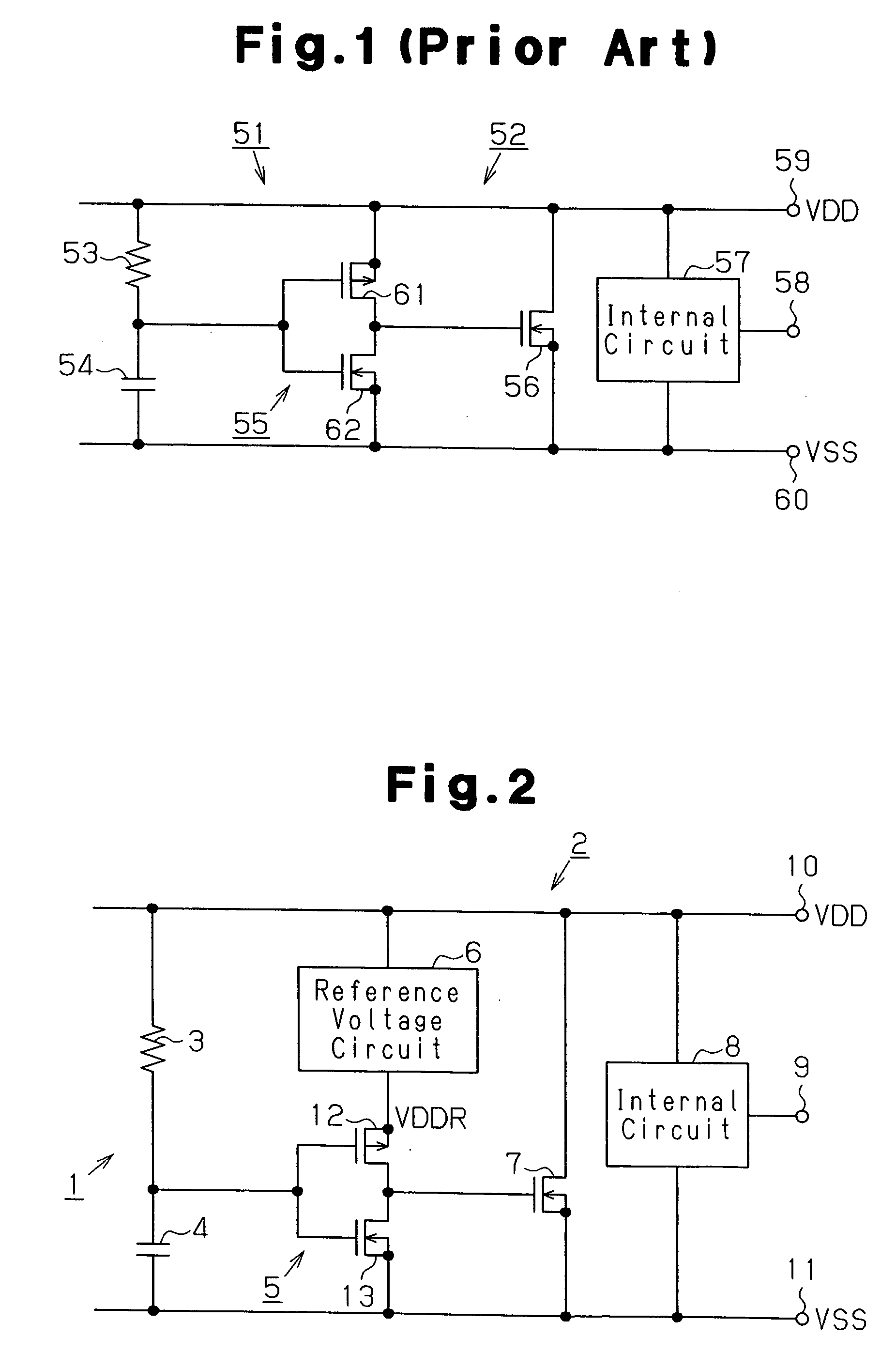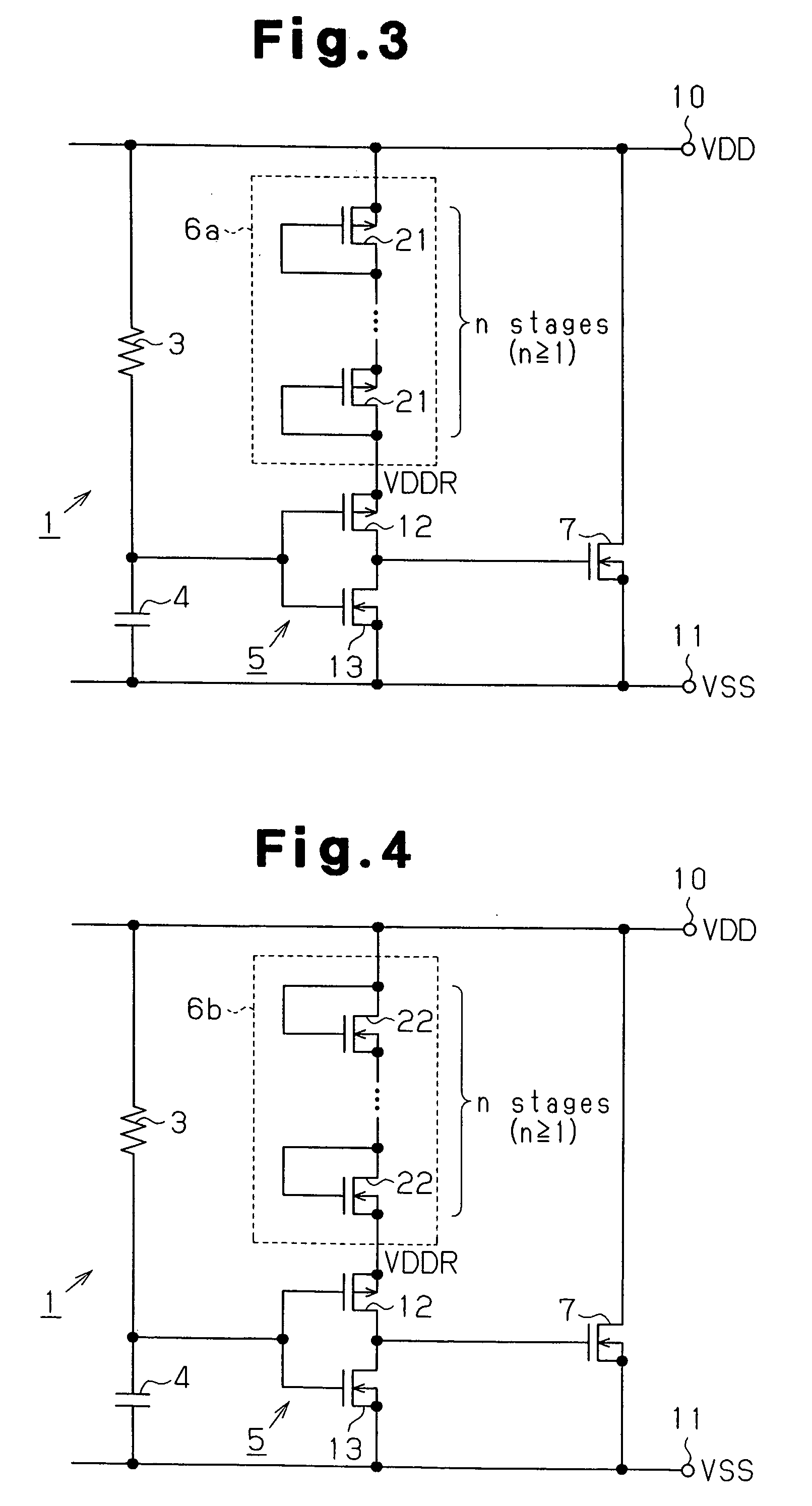Power clamp circuit and semiconductor device
a power clamp circuit and semiconductor technology, applied in the field of semiconductor devices, can solve the problems of increasing current consumption and accelerating the consumption of battery current, and achieve the effect of increasing current consumption
- Summary
- Abstract
- Description
- Claims
- Application Information
AI Technical Summary
Benefits of technology
Problems solved by technology
Method used
Image
Examples
first embodiment
[0025] A power clamp circuit 1 according to the present invention will now be described with reference to FIGS. 2 to 5.
[0026]FIG. 2 is a schematic circuit diagram showing the power clamp circuit 1 according to a first embodiment of the present invention.
[0027] A semiconductor device 2, which is preferably an LSI, includes the power clamp circuit 1 and an internal circuit 8. The power clamp circuit 1 includes a resistor 3, a capacitor 4, a buffer circuit 5, a reference voltage circuit 6, and an N-channel type MOS transistor 7 functioning as a clamp element. The internal circuit 8 is connected to an I / O terminal 9 for input and output of signals, a first power supply terminal 10 for supplying a first power supply voltage VDD, and a second power supply terminal 11 for supplying a second power supply voltage VSS. The first power supply voltage VDD is a positive voltage, and the second power supply voltage VSS is a negative voltage.
second embodiment
[0041] The power clamp circuit 31 includes (2n−1) stages of (i.e., an odd number of stages satisfying n≧2) buffer circuits 5 and a reference voltage circuit 6a (FIG. 3). The buffer circuits 5 are connected in series between the transistor 7 and a node between the resistor 3 and the capacitor 4. The reference voltage circuit 6a is connected to at least one of the (2n−1) stages of buffer circuits 5 (except for the final buffer circuit). The reference voltage circuit 6a may be replaced by the reference voltage circuit 6b (FIG. 4) or the reference voltage circuit 6c (FIG. 5).
[0042] Each of the buffer circuits 5 is preferably configured by an inverter circuit. In the second embodiment, among the (2n−1) buffer circuits 5, the reference voltage circuit 6a is connected between the first power supply terminal 10 and the source of the first transistor 12 of the (2n−3)th stage of the buffer circuits 5. Thus, the first power supply voltage VDD is directly supplied from the first power supply t...
third embodiment
[0050] A power clamp circuit 41 according to the present invention will now be described with reference to FIG. 8 focusing on the differences from the above embodiments.
[0051] The power clamp circuit 41 counters power supply noise, which may be produced at the side of the second power supply voltage VSS, in a manner similar to the above embodiments. Specifically, the N-channel type MOS transistor 7, which functions as a clamp element, is replaced by a P-channel type MOS transistor 7a, and the reference voltage circuit 6b (see FIG. 4) is connected between the second power supply terminal 11 and the source of the second transistor 13 of the buffer circuit 5. The reference voltage circuit 6b may be replaced by the reference voltage circuit 6a (FIG. 3) or the reference voltage circuit 6c (FIG. 5).
[0052] The power clamp circuit 41 includes 2n stages of buffer circuits 5 (i.e., an even number of stages satisfying n>1), with each buffer circuit being configured by an inverter circuit. At ...
PUM
 Login to View More
Login to View More Abstract
Description
Claims
Application Information
 Login to View More
Login to View More - R&D
- Intellectual Property
- Life Sciences
- Materials
- Tech Scout
- Unparalleled Data Quality
- Higher Quality Content
- 60% Fewer Hallucinations
Browse by: Latest US Patents, China's latest patents, Technical Efficacy Thesaurus, Application Domain, Technology Topic, Popular Technical Reports.
© 2025 PatSnap. All rights reserved.Legal|Privacy policy|Modern Slavery Act Transparency Statement|Sitemap|About US| Contact US: help@patsnap.com



